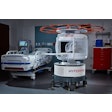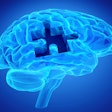
When Super Bowl XLIX kicks off on Sunday, it will be the culmination of months of hard work for players, coaches, and staff who take the field at University of Phoenix Stadium in Arizona. Off the field, radiologists are playing a growing role for NFL teams by providing definitive diagnoses that help injured athletes recover and get back on the field faster.
Working with an NFL team offers a number of challenges for radiologists, who often must shuffle clinical schedules to accommodate the workload from injured athletes. Reading the scans of professional athletes is a high-pressure environment where coaches, trainers, and agents demand rapid, accurate diagnoses that in some cases can make a huge difference in a team's season -- and in a player's career.
But radiologists who read for the NFL can also enjoy rewards that trickle down into routine clinical practice, becoming better radiologists in the process.
The Miami Dolphins
Dr. Juan Batlle has been working with the Miami Dolphins since 2011 as part of his practice, Radiology Associates of South Florida. Radiology Associates is the radiology group that serves Baptist Health South Florida, which has contracted with a number of Florida-based sports teams, including the Miami Heat basketball club and the Florida Panthers hockey team.
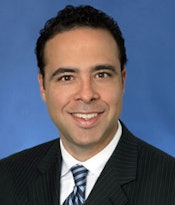 Dr. Juan Batlle.
Dr. Juan Batlle.Like other radiology groups involved with football teams, Radiology Associates comes to its relationship with the Dolphins through its association with an orthopedic group, in this case UHZ Sports Medicine Institute, which provides services to the Dolphins, as well as Baptist Health. Batlle is one of three subspecialists in musculoskeletal radiology who provide reads for UHZ and the Dolphins.
While radiologists with Radiology Associates are on call 24/7, Batlle said most of the work from the Dolphins tends to come in on the Monday after a game. Many practice facilities and stadiums have x-ray systems located onsite, but radiographs from these units are typically read by orthopedic physicians and are usually used for ruling out obvious trauma such as fractures or joint separations.
More complex questions require more advanced imaging, such as musculoskeletal MRI, Batlle said. Only a small number of stadiums have MRI scanners onsite, so players are typically sent on Monday to the same imaging facilities used by regular patients.
The confidentially of athletes is a major concern, so Batlle's practice has ensured that there are separate dressing facilities for players. Batlle said he never speaks about any athletes whose scans he has read until he sees that their status has been reported in the media, and his facility uses an auditing system to track whether any unauthorized viewing of an athlete's images has occurred in the PACS.
The Cleveland Browns
Dr. Peter Young of University Hospitals Case Medical Center has been a lifelong fan of the Cleveland Browns. So he and other Browns fans in the radiology department at University Hospitals were delighted when the health system won the contract to provide medical services to the team starting with the 2014 season (which is also the 50th anniversary of the Browns' storied 1964 NFL championship, the last time a Cleveland franchise won a championship in any sport, Young noted).
The radiology department at University Hospitals handles imaging for Browns players as well as for front-office executives with the team, who are on the same health plan as the athletes. Most of the imaging orders come through Dr. James Voos, an orthopedic surgeon with University Hospitals who is the team's head physician.
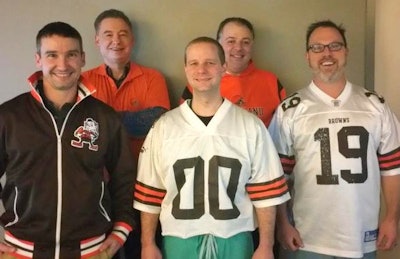 University Hospitals' musculoskeletal radiology team, from left to right: Nathan Fergus (fellow), Dr. Mark Robbin, Marcus Kirkpatrick (fellow), Dr. Christos Kosmas, and Dr. Peter Young.
University Hospitals' musculoskeletal radiology team, from left to right: Nathan Fergus (fellow), Dr. Mark Robbin, Marcus Kirkpatrick (fellow), Dr. Christos Kosmas, and Dr. Peter Young.Young wears two hats, the first as one of three musculoskeletal radiologists who reads studies, and the second as the radiology group's director of medical imaging, a liaison position designed to ensure that operations go smoothly and players have easy access to imaging and timely interpretations.
A plain-film radiography system is installed at the Browns' stadium, but that unit isn't linked with the PACS network at University Hospitals, so those images are read by orthopedic physicians onsite. Radiologists do receive images from a digital radiography (DR) unit installed at the Browns' practice facility in Berea, OH, while advanced imaging is performed at facilities operated by University Hospitals.
As with other football radiologists, Young has encountered some challenges in integrating studies from the Browns with the regular workload. The department has closed its schedule to elective procedures on Mondays and also rescheduled its weekly quality meeting so that Young can work with Browns players.
The Dallas Cowboys
Dr. Anthony Toppins has been working with the Dallas Cowboys for 15 years, a responsibility he carried with him when he joined his current radiology group, Radiology Partners, in 2012. Also a musculoskeletal radiologist, his experience illustrates that there's more to working with an NFL team than just reading scans of injured athletes after game day.
Each year, Toppins accompanies Cowboys staff to the NFL's scouting combine, an intensive weeklong camp at which several hundred college athletes are prodded, poked, measured, and tested in preparation for the draft. Held each February in Indianapolis, the combine gives professional teams advance information on which players they should be targeting.
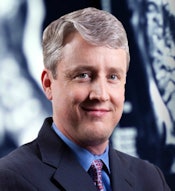 Dr. Anthony Toppins.
Dr. Anthony Toppins.The Cowboys were one of the first NFL teams to bring a radiologist to the combine, Toppins noted. At the event, he evaluates the medical status of players, reviews prior imaging exams, and performs new studies.
Toppins sees the combine as a sort of investigative process to flesh out the medical histories of players. Athletes are interviewed by the team's training staff members, who review the different extremities and the players' medical backgrounds. Toppins, the orthopedic surgeons, and other Cowboys staff then review CT and MRI scans to determine if there are any other issues that could affect the grading of an athlete in preparation for draft day.
Toppins said that much of the work at the combine is focused on identifying potentially dangerous conditions that athletes should address before they move on to the professional level. In addition to the musculoskeletal scans that Toppins reads, echocardiograms and electrocardiograms are performed by other clinicians to identify cardiac abnormalities that could be life-threatening, and the athletes also undergo screening for conditions such as sickle cell anemia and even psychiatric evaluation.
Radiologists like Toppins have become indispensible parts of the medical staff for NFL teams, according to Jim Maurer, head athletic trainer of the Cowboys. At one time, the Cowboys were the only football team with a radiologist at the combine, but now half the teams use specialty radiology reads, he said.
One of the things Toppins enjoys most about the combine is that for four to five days he works side by side with orthopedic surgeons and athletic trainers, offering the specialized expertise that only a radiologist can provide. It's a working relationship that he wishes took place throughout medicine.
"When a radiologist is reading films one after another in a worklist, the radiologist does a great job, but I think it goes to another level when a radiologist is in a clinical area with orthopedic surgeons where they can speak to one another," Toppins said. "This is something that doesn't happen in day-to-day radiology, and it is imminently valuable."
Clinical findings
What sort of pathologies do radiologists working with the NFL see? Many of the injuries are similar to the sorts of musculoskeletal issues found in a typical weekend warrior, but with subtle differences.
For example, hamstring injuries are very common, Young said, with small tears constituting a sizable component of the MRI cases that are sent to University Hospitals. Maurer of the Cowboys also cited hamstring tears as a condition where MRI gives important details about the significance of the injury -- which can affect the duration of an athlete's recovery.
In addition, Young said he was surprised by how many post-traumatic and degenerative injuries are already present in athletes. This can make the diagnosis of acute injuries more challenging.
"I thought players were young men in their 20s and 30s, so we would see a lot of acute injury on top of normal anatomy, but many players have been playing since high school and college, have a number of injuries, and have had surgeries on knees and shoulders," he said. "That is a change from the usual sports medicine cases."
Some teams such as the Miami Heat have begun performing baseline imaging studies on healthy athletes before the season begins to document what their anatomy looks like before an acute injury occurs. In the Heat's case, these are usually plain radiography studies of the knee, which tends to be one of the most frequently injured body parts in basketball.
Concussion has become a major concern in football, but most radiologists contacted by AuntMinnie.com said they very rarely see brain scans of concussed athletes. Concussion is typically handled with a clinical protocol, and it's not routine to send athletes with suspected concussion straight to imaging. Instead, studies like CT scans are reserved for players who have other symptoms or are experiencing a delay in returning to the field, Young said.
Still, he said he can foresee a time in the future when athletes might receive baseline neuroimaging scans similar to the knee radiographs used by the Heat. Written cognitive tests are already being used to assess athletes at the beginning of a season to establish a level of cognitive function before an injury. Functional MRI could offer a more rigorous approach, he noted.
Imaging's advances
What's driving the growing role of radiology in sports medicine? The radiologists interviewed by AuntMinnie.com agreed that it's due in large measure to the growing power of MRI to shed light on injuries that were invisible on other modalities, particularly plain radiography.
"I've been with the Cowboys for 25 years, and the evolution of MRI has helped us diagnose many injuries that were unclear in the early years of sports medicine," Maurer said. "Athletes can have symptoms, but you don't see it until you see the imaging."
Batlle concurs.
"Twenty to 30 years ago, there wasn't much CT and MRI done; it was plain film and was handled by orthopedic physicians," Batlle said. "Now, the radiologist has become more and more important."
Young echoed that sentiment, noting that MRI's ability to grade the severity of an injury precisely -- and thus predict when an athlete might return to play -- has fueled a subculture of sports medicine junkies.
"I think that public awareness of sports medicine injuries has definitely gone up with the advent of MRI," he said. "When I was child watching football in the '80s and '90s, no one would have heard of a partial tear of an MCL [medial collateral ligament], but now that is routine discussion on ESPN and how many weeks it might cause a player to be out."
Challenges and victories
Working with an NFL team might seem to carry a certain cachet, but there are definitely challenges to the work. Both Batlle and Toppins cited the high-pressure nature of reading scans of athletes who are paid in the millions, where definitive answers are needed without delay.
"You will not be given a day to reflect on the case," Batlle said. "You have to know your limitations and strengths and be able to confidently make a diagnosis."
That was echoed by Toppins, who stressed that despite the conflicting pressures from teams and agents, in the end he and his partners strive to do right by the players.
"We do our best to maximize their safe playing time without jeopardizing their health and the longevity of their playing careers," he said. "That creates stress."
In the end, all of the radiologists AuntMinnie.com spoke with felt that their work with NFL athletes benefited their daily clinical practice.
Batlle found that reading for the Dolphins has helped him recognize similar but more subtle pathology that might occur in the weekend warriors seen in a typical musculoskeletal practice. Young said that frequently reading musculoskeletal pathology on Browns athletes has helped him recognize clinical conditions in his daily practice. The relationship with the NFL has also been a major boon in education at University Hospitals, particularly for residents and fellows.
Toppins also shared that perspective on his work for the Cowboys.
"There's a difference between reading an MRI on an NFL running back and reading an MRI on a weekend warrior, but what the referring physician needs is the same: It is a very concise interpretation that gives them guidance and gives them diagnosis -- and not a lot of waffling," Toppins said. "This experience has made me more decisive in interpretations."

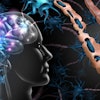
.fFmgij6Hin.png?auto=compress%2Cformat&fit=crop&h=100&q=70&w=100)
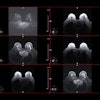


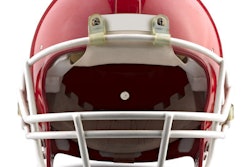
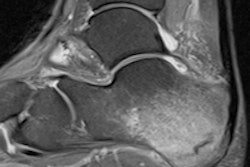
.fFmgij6Hin.png?auto=compress%2Cformat&fit=crop&h=167&q=70&w=250)









